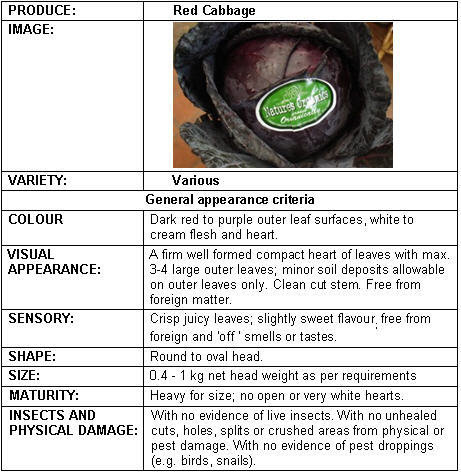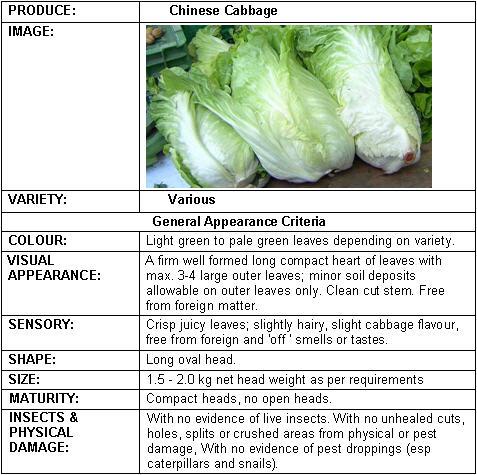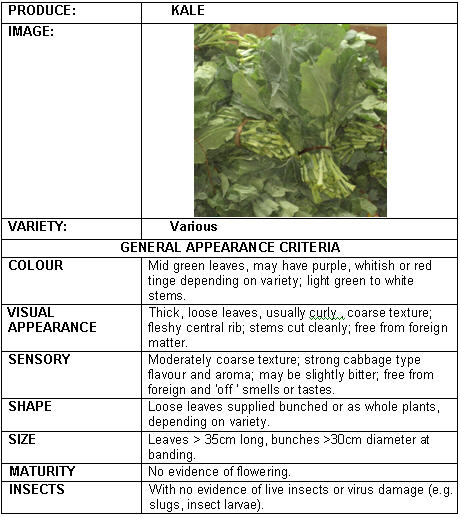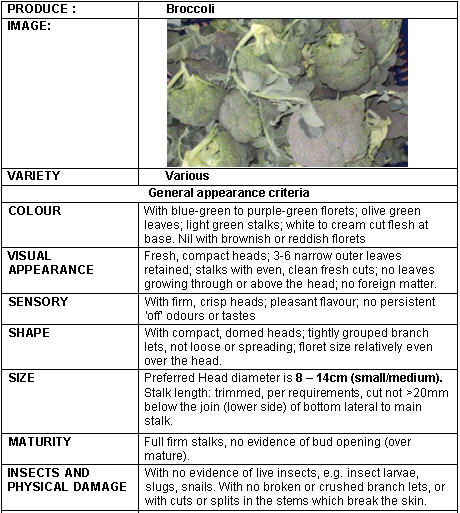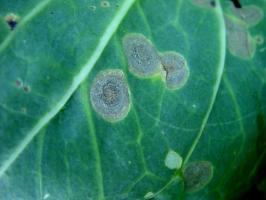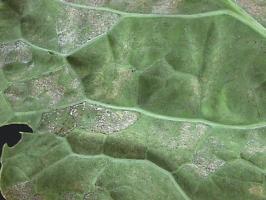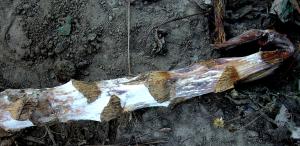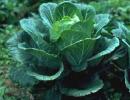 |
Cabbage/Kale, Brassicas
Scientific name:
Brassica spp.
Family:
Capparales: Cruciferae/Brassicaceae
Local names:
Kenya: Sukuma wiki (Swahili)
Common names and related Brassicas:
Cabbage, kale, choumolea, Chinese cabbage, cauliflower, rape, broccoli, Brussels sprouts, kohlrabi, savoy, turnip.
Pests and Diseases: Alternaria leaf spot
Aphids
Bacterial soft rot
Bagrada bug
Black rot
Broomrape
Cabbage looper
Cabbage moth
Cabbage webworm
Cauliflower Mosaic Virus
Cercospora leafspots
Clubroot
Cutworms
Damping-off diseases
Diamondback moth (DBM)
Downy mildew
Leafmining flies (leafminers)
Powdery mildew
Sawflies
Snails (Giant East African Snail)
Thrips
Turnip Mosaic Virus (TuMV)
White rust
Whiteflies
|
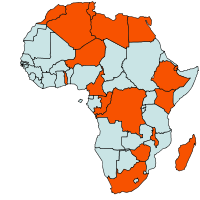 |
| Geographical Distribution of Cabbage/Kale and Brassicas in Africa |
Brassicas constitute the majority of cultivated Cruciferae in eastern and southern Africa. The main brassicas grown in the region include:
- Cabbage (Brassica oleracea L. var. capitata)
- Kale (sukumawiki) or choumolea (B.o. acephala)
- Chinese cabbage(B. campestris chinensis/pekinensis)
- Cauliflower (B.o botrytis)
- Rape B.carinata (indigenous), and B.napus, (exotic type).
Other brassicas grown in the region are broccoli, Brussels sprouts, kohlrabi, savoy and turnip.
Also grown in the region are radish (Raphanus sativus L. var. hortensis) and horseradish (Armoracia rusicana Gaertn.)
These vegetables are grown mainly for the local market. They are valuable as sources of vitamins and minerals, as well as a source of cash for smallscale farmers in rural and peri-urban areas. However, production is often constrained by damage caused by a range of pests (insects, diseases, nematodes and weeds).
The range of pests attacking the different brassicas is similar, but the relative importance of individual pest species varies between the different crops.
Cabbage is mainly sold fresh or as processed canned product. Processed products include those that are treated in vinegar, or fermented such as sauerkraut or kimchi. Fresh cut or lightly processed products include coleslaw and ready-to-eat salad mixes that contain shredded cabbage. Consumers generally prefer fresh green cabbage, when available, to stored cabbage. Much of the stored cabbage is grown for processing.
Nutritive Value per 100 g of edible Portion
| Raw or Cooked Cabbage/Kale /Brassica | Food Energy (Calories / %Daily Value*) |
Carbohydrates (g / %DV) |
Fat (g / %DV) |
Protein (g / %DV) |
Calcium (g / %DV) |
Phosphorus (mg / %DV) |
Iron (mg / %DV) |
Potassium (mg / %DV) |
Vitamin A (I.U) |
Vitamin C (I.U) |
Vitamin B 6 (I.U) |
Vitamin B 12 (I.U) |
Thiamine (mg / %DV) |
Riboflavin (mg / %DV) |
Ash (g / %DV) |
| Broccoli cooked | 35 / 2% | 7.2 / 2% | 0.4 / 1% | 2.4 / 5% | 40.0 / 4% | 67.0 / 7% | 0.7 / 4% | 293 / 8% | 1548 IU / 31% | 64.9 / 108% | 0.2 / 10% | 0.0 / 0% | 0.1 / 4% | 0.1 / 7% | 0.8 |
| Brussel Sprouts cooked | 36.0 / 2% | 7.1 / 2% | 0.5 / 1% | 2.5 / 5% | 36.0 / 4% | 56.0 / 6% | 1.2 / 7% | 317 / 9% | 775 IU / 15% | 62.0 / 103% | 0.2 / 9% | 0.0 / 0% | 0.1 / 7% | 0.1 / 5% | 0.9 |
| White Cabbage cooked | 23.0 / 1% | 5.5 / 2% | 0.1 / 0% | 1.3 / 3% | 48.0 / 5% | 33.0 / 3% | 0.2 / 1% | 196 / 6% | 80.0 IU / 2% | 37.5 / 62% | 0.1 / 6% | 0.0 / 0% | 0.1 / 4% | 0.0 / 0% | 0.6 |
| Red Cabbage cooked | 29.0 / 1% | 6.9 / 2% | 0.1 / 0% | 1.5 / 3% | 42.0 / 4% | 33.0 / 3% | 0.7 / 4% | 262 / 7% | 33.0 IU / 1% | 34.4 / 57% | 0.2 / 11% | 0.0 / 0% | 0.1 / 5% | 0.1 / 4% | 0.6 |
| Savoy Cabbage cooked | 24.0 / 1% | 5.4 / 2% | 0.1 / 0% | 1.8 / 4% | 30.0 / 3% | 33.0 / 3% | 0.4 / 2% | 184 / 5% | 889 IU / 18% | 17.0 / 28 % | 0.2 / 8% | 0.0 / 0% | 0.1 / 3% | 0.0 / 1% | 0.7 |
| Chinese Cabbage cooked | 14.0 / 1% | 2.4 / 1% | 0.2 / 0% | 1.5 / 3% | 32.0 / 3% | 39.0 / 4% | 0.3 / 2% | 225 / 6% | 967 IU / 19% | 15.8 / 26% | 0.2 / 9% | 0.0 / 0% | 0.0 / 3% | 0.0 / 3% | 0.7 |
| Cauliflower cooked | 23.0 / 1% | 4.4 / 1% | 0.5 / 1% | 1.8 / 4% | 16.0 / 2% | 32.0 / 3% | 0.3 / 2% | 142 / 4% | 12 IU / 0% | 44.3 / 74% | 0.2 / 9% | 0.0 / 0% | 0.0 / 3% | 0.1 / 3% | 0.6 |
| Kale cooked | 28.0 / 1% | 5.6 / 2% | 0.4 / 1% | 1.9 / 4% | 72.0 / 7% | 28.0 / 3% | 0.9 / 5% | 228 / 7% | 13623 IU / 272% | 41.0 / 68% | 0.1 / 7% | 0.0 / 0% | 0.1 / 4% | 0.1 / 4% | 0.9 |
| Kohlrabi cooked | 29.0 / 1% | 6.7 / 2% | 0.1 / 0% | 1.8 / 4% | 25.0 / 2% | 45.0 / 4% | 0.4 / 2% | 340 / 10% | 35.0 / 1% | 54.0 / 90% | 0.2 / 8% | 0.0 / 0 % | 0.0 / 3% | 0.0 / 1% | 1.1 |
| Radish raw | 16.0 / 1% | 3.5 / 1% | 0.1 / 0% | 0.7 / 1% | 25.0 / 2% | 20.0 / 2% | 0.3 / 2% | 233 / 7% | 7.0 IU / 0% | 14.8 / 25% | 0.1 / 4% | 0.0 / 0% | 0.0 / 4% | 0.0 / 0% | 0.5 |
| Turnip Greens cooked | 20.0 / 1% | 4.4 / 1% | 0.2 / 0% | 1.1 / 2% | 137 / 14% | 29.0 / 3% | 0.8 / 4% | 203 / 6% | 7626 IU / 153% | 27.4 / 46% | 0.2 / 9% | 0.0 / 0% | 0.0 / 3% | 0.1 / 4% | 1.1 |
| Turnip Roots cooked | 22.0 / 1% | 5.1 / 2% | 0.1 / 0% | 0.7 / 1% | 33.0 / 3% | 26.0 / 3% | 0.2 / 1% | 177 / 5 % | 0.0 IU / 0% | 11.6 / 19% | 0.1 / 3% | 0.0 / 0% | 0.0 / 2% | 0.0 / 1% | 0.5 |
Cabbage grows well on a wide range of soils with adequate moisture and fertility. Soil pH in the range of 6.0-6.5 is preferred, but cabbage will tolerate a soil pH range of 5.5 to 6.8. Cabbage is a heavy feeder, so to get good yields, proper fertilisation is necessary.
To maintain growth, cabbage requires a consistent supply of moisture, and should as a general rule receive a minimum of 2.5 cm of water per week. Larger quantities may be required when cabbage is grown on sandy soils or when evapotranspiration is high.
Nutrient deficiencies
Growing healthy plants is the best way of avoiding problems. Healthy plants grow on a healthy and well nourished soil with a good texture. Good compost is the best and most balanced soil and plant feed available to farmers. Regardless of soil type, excessive N (nitrogen) can promote second growth and split heads. A high level of nitrogen will also shorten storage life of cabbage and promote pungent odour (strong smells) during cooking.
Combined with high temperatures, excess N (nitrogen) can promote such rapid growth that plants show symptoms of tip burn in susceptible cultivars. Depressed yields, delayed maturity, reduced keeping quality and strong or objectionable flavours are indicative of N deficiency. Like most cruciferous crops, cabbage has a high requirement for boron and molybdenum. Boron deficiency causes yellowing or chlorosis of the youngest leaves and stems, which often starts from the base and extends to the tip, hollow and discoloured inside stems of broccoli and cauliflower, and hollow and/or shrunken roots of turnips.
Rosetting or even death of terminal shoots or buds occurs in extreme cases. The common symptoms of molybdenum deficiency in cabbage include a general yellowing, marginal and interveinal chlorosis, marginal necrosis, rolling, scorching and downward curling of margins usually on older leaves. Compost and well rotted animal manures are good sources of most micronutrients including boron and molybdenum.
Land preparation and management
- Prepare land well before transplanting.
- Avoid field operations when it is wet. This will help to prevent inadvertent spread of diseases from plant to plant and movement of infested soil within and outside the field.
- Keep fields free of weeds. Especially weeds of the brassica family are potential alternative hosts of insect pests and diseases and are nutrient competitors.
- Ensure optimal fertilisation. Cabbage has a very shallow root system and is particularly responsive to phosphorus. Where the soil has a low phosphorus content the application of 'Mijingu Rock Phosphate' is recommended.
- Practise crop rotation: site seedbeds on land not previously under crucifers, and preferably away from old crucifer fields.
- Use clean wooden trays to raise seedlings, use mixture of compost and top soil or forest soil for raising seedlings.
- Heat soil in the seedbed: place plenty of crop trash or straw and burn for at least 30 min, and after cooling, mix the soil with compost in equal proportions.
- Use certified disease free seed of resistant/tolerant cultivars.
- Mulch seedlings in the seedbed, if possible.
- Do not over water seedlings in the seedbed: water seedlings early in the morning and thin out seedlings to avoid plant congestion in the seedbed. Excessive watering is conducive to damping-off diseases, and extended wetness of seedlings favours development of foliar diseases.
Seeds:
Treating own seed in hot water to prevent seed-borne diseases such as black rot, black leg, black spot and ring spot is recommended where these diseases have previously appeared Hot water treatment of seeds helps reduce the seed-borne pathogens. However, the specified temperature and time interval should be strictly followed in order to maintain seed viability. Use a good thermometer or better ask for assistance from qualified personnel from your local agriculturist office.
Recommended temperature and time for hot water treatment for broccoli, cabbage, cauliflower, kale kohlrabi and turnip is 50°C (122 F) for 30 minutes.
For more details on hot water treatment click here
Cabbage varieties
"Globe Master F1 Hybrid"
"Gloria F1 Hybrid"
"Blue Dynasty F1":
"Victoria F1"
"Oxylus F1"
"Green Coronet F1 Hybrid"
"Riana F1 Hybrid"
"Super Master F1"
"Santar F1"
"Field Winner F1 Hybrid"
"CPI"
"Pruktor F1 Hybrid"
"Hero F1 (Sokoni)"
"Chihili"
"Red Dynasty F1"
"Ruby Perfection F1 Hybrid"
"Copenhagen Market"
"Glory of Enkhuizen"
"Prize Drumhead"
"Sugar Loaf"
Broccoli varieties
"Calabrese"
"Heritage F1"
"Dandy Early No. 32 F1"
"Early Green F1"
Cauliflower varieties
"Snowball"
"Snow Crown F1 Hybrid"
"Extra Early Six Weeks"
"Kibo Giant"
"Fremont F1"
"Italian Giant"
"Wallaby"
Kale varieties
"Thousand Headed"
"Southern Georgia"
"Marrow Stem"
- Cabbage is often planted on raised beds that are shaped from bare soil after ploughing and disking. This technique is popular on level soils where furrow irrigation is also used. Bed culture is also used in other areas to improve soil drainage or when plastic mulch is used. The trend has been toward increased use of conservation tillage, particularly on steeply-sloping soils prone to erosion. Producing cabbage using conservation tillage reduces the number of field passes by farm equipment, thus reducing compaction, preserving equipment and conserving fuel.
- Conservation tillage systems cause minimum disturbance to the soil after the previous crop has been harvested. Crop residues are left in the field to reduce soil erosion, conserve moisture, inhibit weed growth, and act as green manure. There are several types of conservation tillage in use, as well as combinations of conservation and conventional tillage. However, in disease management, crop residues must be either removed from the field and destroyed or deeply ploughed to reduce sources of disease infection and spread.
- Advantages of conservation tillage for cabbage production include less machinery, labour and fuel, as well as reduced soil erosion and compaction. Disadvantages of conservation tillage include lower soil temperatures, slower germination and emergence when direct sowing is used, slower early growth, delayed competition with weeds, higher incidence of root diseases, heavier crop residue, the possibility of more difficult planter operation, weed spectrum changes, and potential increase of soil insect pests or insects that spend part of their life cycle in the soil (e.g. cutworms, thrips, leafmining flies, grubs). Cultivation exposes these pests to desiccation by the sun heat and to predation by natural enemies
Intercropping
- Intercrop brassica crops with trap crops or repellent plants, to reduce pest infestation. Tomato reportedly repels diamondback moth and Indian mustard acts as a trap crop. Intercropping brassicas with spinach, beans or dill reportedly reduces aphid infestation.
- Tomatoes when planted 14 days before cabbage reduce the incidence of and damage by diamondback moth. Cabbage intercropped with tomato, coriander or garlic, combined with the application of neem seed kernel extract protects plants from diamondback moth in the field. Indian mustard, Chinese cabbage, and radish are good trap crops for controlling cabbage webworm, flea hopper, and mustard aphid when planted in every 15 rows of cabbage. The mustard row is either in the outermost or in the middle row to avoid caterpillars being blown by wind into the cabbage plants. To control cabbage head caterpillar, Indian mustard should be planted 12 days before transplanting cabbage. Do not plant cabbage where members of the cabbage family have been grown for 3 consecutive years to avoid serious problems of pests and diseases (especially soil borne diseases).
Monitoring
It entails regular field observation during the crop production cycle for pests, diseases, weeds and general aspects of crop health like nutrition and water requirements. Field monitoring methods are virtually the same, but most importantly, in the process is problem recognition. Thus it is very important to be able to identify pests and diseases and to differentiate a pest from a beneficial insect, a pest damage from disease damage, and a pest or disease damage from nutritional problems or physiological disorders.
- Monitor fields regularly for pest and disease occurrence. Early detection of pests and diseases is important as outbreaks are easier controlled in the initial stages. Cutworms and other insects can do a lot of damage in just 1 or 2 days.
- Scout for caterpillar presence: feeding damage and caterpillar excrement give an indication of their activity. Scouting can be done by walking in a zigzag pattern through the field.
- Check for aphids and whether parasitised aphids (mummies) and natural enemies such as ladybird beetles and lacewings are present. Since aphid populations are often clustered, all portions of the field should be checked. For more information on natural enemies click here.
- Scout for the major brassica diseases (refer to major diseases below).
Field sanitation
Remove crop residues immediately after harvest and also remove volunteer plants from the field.
|
|
||||
|
|
Aphids
Several species of aphids attack brassicas in East Africa:
The cabbage aphid (Brevicoryne brassicae)
The false cabbage aphid (Lipaphis erysimi)
The green peach aphid (Myzus persicae)
In particular the cabbage aphid is a major pest in the region. Cool, dry weather is most favourable for aphid development. Large numbers of aphids may kill small plants. Their feeding can distort leaves of older plants and causes leaf curl.
Often, the most serious problem associated with aphids is virus transmission. The cabbage aphid and the false cabbage aphid are vectors of virus diseases such as cabbage black ring spot, cabbage ring necrosis, and mosaic diseases of cauliflower, radish and turnip.
- Aphid colonies in the heads of cabbage are almost impossible to remove before marketing. Natural enemies can provide control, but they usually do not build up fast enough to keep heavy aphid populations below damaging levels. Extensive use of broad-spectrum insecticides like pyrethroids might induce resistance development in aphids and will eliminate natural enemies. For more information on natural enemies click here.
- Insecticidal soaps provide control, and spot sprays of pyrethrum or neem can prevent build up of large populations.

Colony of the cabbage aphid (Brevicoryne brassicae) on kales. Cabbage aphids are about 1.5 - 2.5mm in size.
© A. M. Varela, icipe

Cabbage ap…

Cabbage ap…

Cabbage ap…

Cabbage ap…
Sawflies (Athalia spp)
Sawflies are sporadic but serious pests of brassicas. The cabbage sawfly (Athalia sjostedti) has been reported as a major pest in Tanzania. Sawfly adults are wasps with dark head and thorax, bright yellow abdomen, and two pairs of membranous wings. They are about 1 cm long. Eggs are laid singly inside the leaf. Larvae are oily, black or greenish in colour with a swollen part just behind the head, which makes them appear humped. They look very similar to caterpillars, but they have 6 to 9 pairs of prolegs (abdominal legs), whilst caterpillars have 5 pairs or less. Larvae measure up to 2 cm when fully grown. Larvae eat the blades of leaves leaving just the main veins. They drop from the plant to pupate in the soil.
- Destruction of wild plants of the family of cabbages in the vicinity of the crop.
- Ploughing in of volunteer plants at the end of the season helps reduce sawfly populations.
- Manual collection and destruction of larvae is feasible when there are few sawflies on the crop.
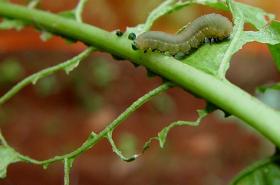
Sawfly larva (Athalia spp) and damage on horseraddish
© A. M. Varela, icipe

Sawflies l…

Sawflies a…
Diamondback moth (DBM) (Plutella xylostella)
It is a serious pest of brassicas and attacks all Brassica species. A full grown diamondback caterpillar is about 1 cm long.
- To control DBM in small farms, cover seedlings with covers (fine nylon mesh) to prevent moths from laying eggs on the leaves and or next to the plant.
- Intercropping brassicas with trap plants such as Indian mustard, and repellent plants such as tomato, reportedly reduces DBM infestation in cabbage. In the case of Indian mustard, control measures are directed at DBM on the trap crop. When intercropping with tomato, the cabbage crop is planted 30 days after tomato.
- Biological control of DBM using parasitoid wasp Diadegma semiclausum has proven very effective in the highlands of Kenya, Tanzania and Uganda.
- Botanicals such as neem-based pesticides are very effective for control of DBM.
- Also Bt sprays are effective against DBM. For more information on Bt click here
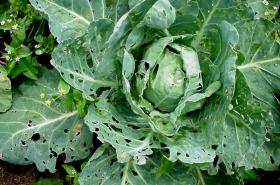
Diamondback moth damage on cabbage
© A. M. Varela, icipe

Diamondbac…

Diamondbac…

Diamondbac…

Diamondbac…
The cabbage looper (Trichoplusia ni)
The cabbage looper is a green caterpillar with faint white stripes along the body. Caterpillars are about 3.5 to 4 cm long when fully-grown. As they move, they arch their back in a looping fashion, hence the common name looper. Larvae (caterpillars) chew holes in the leaves, and larger caterpillars consume great amounts of plant material. On cabbage they eat into the heads, reducing the marketability of the produce.
The adult is a moth about 2.5 cm in length and mottled, greyish-brown.
- Conserve natural enemies. These caterpillars are attacked by a large numbers of natural enemies, including parasitic wasps and flies. Birds and bats feed on the adults (moths).
- Pick caterpillars by hand and destroy them.
- When control is necessary use biopesticides such as neem-based products or Bt. Neem products control cabbage looper by interfering with the growth of the young caterpillar. Bt and neem should be applied when caterpillars (larvae) are still in the early growth stages.
For more information on neem click here.
For more information on Bt click here.
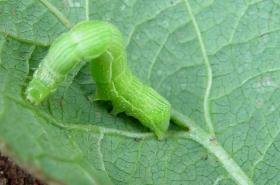
Cabbage looper on cabbage. The first instar larvae is white and almost clear with a black head capsule. Later instars are green with a thin white line on each side. Mature larvae reach 3 to 4 cm in length.
© A.M. Varela, icipe

Cabbage lo…

Cabbage lo…
The cabbage webworm (Hellula undalis)
Caterpillars are 1.5 cm when fully-grown, creamy-white in colour with brown stripes along the body and a brown head. Caterpillars feed on leaves, petioles, growing points, and stems.
- Use neem-based products and Bt.

Cabbage webworm caterpillar (Hellula undalis) and damage on a kale leaf.
© A. M. Varela, icipe

Cabbage we…

Cabbage we…

Cabbage we…
The cabbage moth (Crocidolomia pavonana (=binotalis))
Cabbage moth larva: when fully grown is about 1.6-1.9 cm long. Larvae pupate in the soil. The pupal stage lasts about 10 days.
It is primarily a pest of brassicas and is occasionally an important pest of cabbage and kales. Caterpillars are found in groups. Young caterpillars chew off top leaf surfaces, while older caterpillars feed under a web of silk on young leaves, petioles and growing point of the plant, often damaging it entirely.
- Spray with neem extracts and Bt.
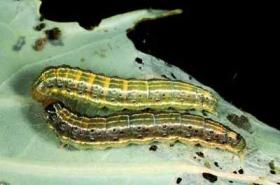
When the cabbage moth larvae is fully grown it is 1.6-1.9 cm long. The larvae move to pupate in the soil. The pupal stage lasts about 10 days.
© Ooi P. Courtesy of Ecoport (www.ecoport.org)

Cabbage mo…

Cabbage mo…

Cabbage mo…
The Bagrada bug (Bagrada hilaris)
It is typically shield-shaped, 5-7mm long and 3-4mm wide. The upper surface has a mixture of black, white and orange markings. Feeding by sucking by both adults and nymphs causes damage to leaves, which wilt later and dry. A heavy attack on young plants generally results in death of the plant.
- Crop hygiene including destruction of weeds of the family Cruciferae prevents population build-up.
- Remove bugs by hand.
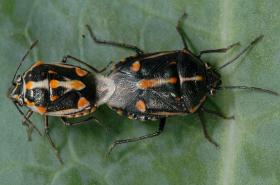
The adult bagrada bug (Bagrada hilaris) is typically shield-shaped, 5-7mm long and 3-4mm wide. The upper surface has a mixture of black, white and orange markings.
© F. Haas, icipe

Bagrada bu…

Bagrada bu…

Bagrada bu…
Cutworms (Agrotis spp)
Cutworms cut the stem of plants below the soil surface. The damaged plant wilts and withers. First instars are 0.7-1 cm, later instars are 3.5-5 cm long.
- Cutworm damage is usually minor and does not warrant control measures. When damaged plants are detected, the cutworms normally can be found near the damaged plant and can be removed by hand.
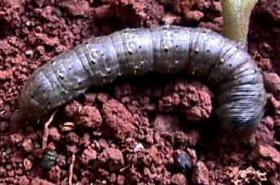
Cutworm (Agrotis sp.)
© A.M. Varela, icipe
Leafmining flies (Lyriomiza brassicae)
Leafmining flies are small about 1.3-1.6 mm in length. Maggots of leafmining flies cause mines while feeding within the leaf. Small, individual leafminers do not produce much damage, but when larvae occur in large numbers, entire leaves can be eaten out. Heavy attacks weaken seedlings and may result in dying off the young plants.
- Leafminers are usually well controlled by existing natural enemies, particularly parasitic wasps. However, this balance can be disrupted by the use of non-selective pesticides.
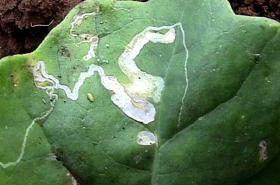
Mines cause by maggots, and a pupa of leafminer flies (Lyriomiza brassicae)
© A.M. Varela, icipe
Thrips (Thrips tabaci Frankliniella spp)
Thrips feeding on cabbage cause rough bronzed blisters on leaves inside the cabbage head. hey are less than 2 mm long. Thrips attacks are not common on brassicas in the eastern and southern Africa region.
- Plough and harrow before transplanting. This can be useful in reducing thrips attacks by killing pupae in the soil.
- Conservation of natural enemies, such as predatory bugs, predatory mites and predatory thrips are important.
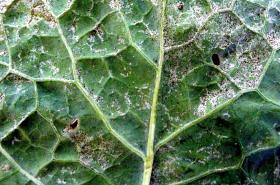
Thrips damage on lower surface of cabbage leaf. Note rough brown patches and small dark spots (thrips faeces)
© A.M. Varela, icipe
Whiteflies (Bemisia tabaci, Trialeurodes vaporariorum and Aleyrodes proletella)
Whiteflies feed on brassicas. Adult whiteflies are about 1 mm long.
In East Africa whitefly populations on brassicas usually do not build up to such an extent that control measures are required.
- Natural enemies such as ladybird beetles, predatory mites and lacewings can play an important role in reducing whiteflies. For more information on natural enemies click here.
- The application of high doses of nitrogen fertiliser favours development of the pest.
- Use mineral oils and neem. For more information on neem click here.
- Spray with soapy water solutions.
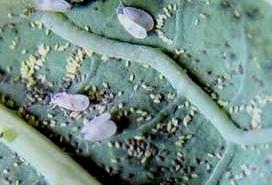
Adults and eggs of the cabbage whitefly (Aleyrodes proletella).
© A. M. Varela, icipe
Black rot (Xanthomonas campestris pv. campestris)
Black rot is caused by the bacterium Xanthomonas campestris pv. campestris, and is one of the most serious cabbage diseases in warm climates. The black rot bacterium can over-season on infected cabbage seeds, in weeds from the family Cruciferae (including: black mustard, field mustard, wild turnip, wild radish, shepherd's purse, and pepperweed); or in infected plant material in the soil.
- Disease-free transplants should be used or seeds must be treated with hot water treatment as described below.
- Hot water treatment of own seed to prevent seed-borne diseases such as black rot, black leg, black spot and ring spot is recommended where the disease has appeared before. However, the specified temperature and time interval should be strictly followed in order to maintain seed viability. Use a good thermometer or better ask for assistance from qualified personnel from your local agriculture office. Recommended temperature and time for heat treatment for cabbage: 50°C: for 30 minutes, for broccoli, cauliflower, kale, kohlrabi, turnip:50°C: for 30 minutes.
For more details on hot water treatment click here. - Establish crops in black rot-free soils that have not grown crops from the family Cruciferae for at least 3 years.
- Growing cabbage on raised beds with mulching helps eliminate conditions that induce black rot.
- When possible, remove, burn, or deep plough all crop debris immediately after harvest to reduce the ability of the bacterium to survive in the soil where there is no crop.
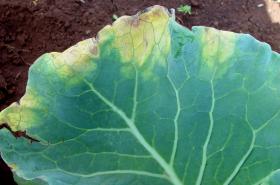
Bacterial black rot Black rot on cabbage. Characteristic yellowish V-shaped areas at the leaf margin, sites of infection by black rot, Xanthomonas campestris pv. campestris.
© A. M. Varela, icipe


Bacterial …

Bacterial …

Bacterial …
White rust (Albugo candida)
It affects every known cruciferous crop. However, this disease is generally less common on cabbage, Brussels sprouts, broccoli and cauliflower than on radish, horseradish, mustard and turnip. Leaves have chlorotic or necrotic spots on their upper surface. Pustules form on the lower side of the leaves, small stems and floral parts.
- Clean up crop refuse and destroy cruciferous weeds.
- Crop rotation of at least 3 years can help reduce the disease.
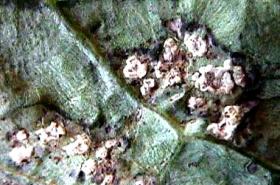
White rust on kales. Note pustules on the lower side of the leaf
© A. M. Varela, icipe
Alternaria leaf spot (Alternaria brassicae)
Alternaria leaf spot or black spot is caused by the fungus Alternaria brassicae. The disease can severely damage cabbage if uncontrolled. The initial symptoms are small, circular, dark spots on older leaf surfaces. As the spots enlarge, concentric rings develop within lesions surrounded by a yellow halo. The tan-coloured centres of lesions may eventually fall out, producing a hole, or under wet conditions, may become covered with masses of black spores. In storage, spots enlarge and soft-rot bacteria may enter lesions.
The pathogen can over-season on crop debris. Weeds from the family Cruciferae may also harbour the fungus. Spores of Alternaria can be spread by wind and water. The disease is most damaging under wet, warm (20-30.5°C) conditions.
- Cabbage should never be grown in fields where other Brassica crops have been grown in the past 3 years.
- Always remove infected plant debris or destroy it after the season.
- Use disease-free transplants.
- Crop rotation will reduce the severity of black spot disease.
- Hot water treatment of own seed to prevent seed.
For more details on hot water treatment click here.
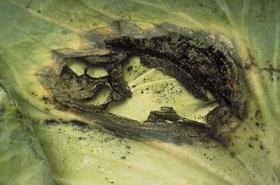
Cabbage black spot - The spots darken with age, and the centers may become thin and papery or drop out, to produce a shot-hole effect.
© Gerlach W. Courtesy of EcoPort, (www.ecoport.org)

Alternaria…

Alternaria…
Clubroot (Plasmodiophora brassicae)
Clubroot caused by the slime mould fungus Plasmodiophora brassicae is particularly serious in Malawi. Its distinctive symptom is an abnormal enlargement of roots or even the underground stem. Its development is favoured by wet, cool, acidic soils.
- Practise crop rotation.
- Irrigate properly.
- Adjust pH to 7.2 with hydrated lime
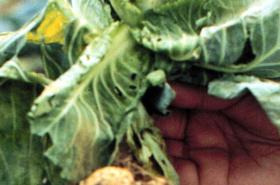
Clubroot on cabbageNote warty growth in the root system
© A.A.Seif, icipe
Bacterial soft rot (Erwinia carotovora var. carotovora)
Bacterial soft rot is caused by Erwinia carotovora var. carotovora. It is quite common on Chinese cabbage in the field. On cabbage, turnip and rutabaga the disease may be found in the field, but is most severe during storage. On cabbage, an initial infection occurs on the outer petiole (leafstalk) which is in contact with the soil, and then progresses to its head. An infected head is watery and often has a complete head rot. The affected area becomes soft and mushy and generally turns dark in colour. Soft rot infection on crucifers almost always emits a foul odour. Eventually the leaves, sterns and roots are entirely decayed by the bacteria. The bacterium is spread in the field by water splashes or contact with tools such as hoes or knives. If contaminated knives are used to harvest cabbages, the stored crop may also rot quickly.
- Plant on ridges or raised beds to prevent waterlogging around the plants.
- Prevent other diseases (e.g. black rot; damping-off) or damage that may provide opportunities for soft rot to develop.
- Avoid harvesting when conditions are warm and moist. These conditions favour the development of soft rot.
- Harvest healthy cabbage heads first and store in a cool, dry, airy place.
- Wash hands and harvesting knives.
- Remove and destroy diseased crop or left over stems in the field after the crop has been harvested.
- Avoid growing brassica crops in the same field for a period of at least three seasons.
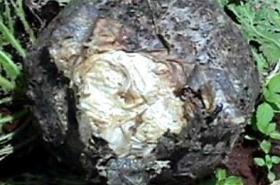
Bacterial soft rot. Note slimy rot (whitish) of the centre of the cabbage head
© A. M. Varela, icipe
Cercospora leafspots (Cercospora brassicicola)
Cercospora leaf spots is caused by the fungus Cercospora brassicicola. Leafspots vary in colour from pale green to white and generally are bordered by brown tissue. They may be circular or appear angular. Severely affected plants may become defoliated. This disease is not economically important in the East African region.
- Use certified disease-free seed and, in case of using own seed, hot water treat the seed. For more information on hot water treatment click here
- Practise proper weed management, particularly, cruciferous weeds such as mustard.
- Remove crop residues from the field after harvest.
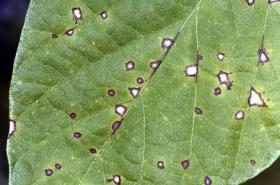
Cercospora leaf spot on soybean
© Clemson University, USDA (EcoPort, www.ecoport.org)
Cauliflower Mosaic Virus (CaMV)
It shows systemic symptoms such as a clearing along the leaf veins (vein clearing). This often is seen first at the base of a leaf. Later symptoms appear as dark green areas along veins (vein banding) and necrotic spotting of the leaf. Chinese cabbage is particularly susceptible to CaMV. In addition to vein clearing a striking mosaic may develop with light and dark green areas seen on the leaves. Plants can be stunted. The main source of CaMV are plants of an infected brassica crop or cruciferous weeds on which a vector has over-seasoned. The virus is transmitted by many species of aphids, such as the cabbage aphid.
- Adequate weed control and sanitation should be practised.
- Plough-down previous crops rapidly.
- Transplant beds should be isolated from commercial crop fields and overwintering cruciferous weed hosts.
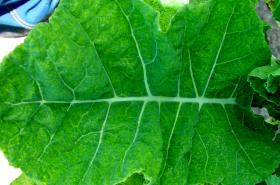
Cauliflower mosaic virus on kales
© A. M. Varela, icipe
Damping-off diseases (Pythium spp., Rhizoctonia solani, Fusarium spp.)
In crucifers, several fungi (e.g. Pythium spp., Rhizoctonia solani, Fusarium spp.) can cause damping-off diseases.
Characteristic is wirestem of seedlings caused by Rhizoctonia solani in the seedbed, bottom rot and head rot in the field, and storage and root rot of horseradish, radish, rutabaga and turnip.
Damping-off diseases are favoured by cool, wet soil conditions.
- Use certified disease-free seeds. If using own seed, treat seeds with hot-water. For more information on hot-water seed treatment click here
- Practise proper irrigation, avoid planting in wet, cold soils
- Plant on raised beds to reduce moisture content in the root zone and provide the appropriate drainage in the field to prevent waterlogged conditions
- Practise crop rotation: seedbeds and production fields should not have had crucifers for at least 3 years. All seedlings with wirestem symptoms should be discarded. During cultivation, take care to avoid throwing soil into plant heads.
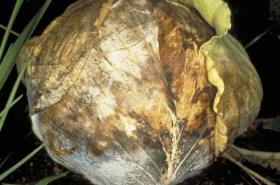
Damping-off (Rhizoctonia solani) on brassica.
© McKenzie, LandCare Ltd., Courtesy of EcoPort

Damping-of…

Damping-of…
Turnip mosaic virus (TuMV)
The first symptoms to develop when Brassica seedlings are inoculated with TuMV are chlorotic spots on inoculated leaves, mottling followed by systemic vein clearing, mosaic and/or necrosis, leaf distortion and often stunting.
- Remove TuMV-infected plant debris and eradicate infected plants around fields as this can help to reduce virus inoculum and hence spread.
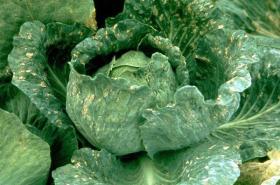
Turnip Mosaic Virus symptoms on cabbage leaves
© Image supplied by Warwick HRI, University of Warwick.
For more details on hot water treatment click here.
|
|
|
- AVRDC Training Center: Cabbage www.avrdc.org
- CAB International (2005). Crop Protection Compendium, 2005 edition. Wallingford, UK www.cabi.org
- Dobson, H., Cooper, J., Manyangarirwa, W., Karuma, J., Chiimba, W. (2002). Integrated Vegetable Pest Management. Natural Resources Institute, University of Greenwich, UK. ISBN: 0-85954-536-9
- East African Seed Co. Ltd. Africa's Best Grower^s Guide www.easeed.com
- Nega, E., Ulrich, R. Werner, S. und Jahn, M. (2003). Hot water treatment of vegetable seed - an alternative seed treatment method to control seed borne pathogens in organic farming. Journal of Plant Diseases and Protection 110(3):. 220-234. www.orgprints.org
- Nutrition Data www.nutritiondata.com.
- OISAT: Organisation for Non-Chemical Pest Management in the Tropics www.oisat.org
- Varela, A.M., Seif, A. A., Löhr, B. (2003). A Guide to IPM in Brassicas Production in Eastern and Southern Africa. ICIPE Science Press, Nairobi. ISBN: 92 9064 148 7
- Amiran Kenya Ltd. seeds@amirankenya.com
- Corner Shop, Nairobi. cls@mitsuminet.com
- Dipchem East Africa Ltd. technical@dipchemafrica.com +254722653995
- East African Seed Company. www.easeed.com
- East African Seed Company. www.easeed.com
- Food Network East Africa Ltd. info@organic.co.ke +2540721 100 001
- Green Dreams. admin@organic.co.ke +254721 100 001
- HCDA. md@hcda.or.ke www.hcda.or.ke +2542088469
- Kalimoni Greens. kalimonigreens@gmail,com +254722 509 829
- Karen Provision Stores, Nairobi. karenstoresltd@yahoo.com +25420885552
- Muthaiga Green Grocers, Nairobi
- Nakumatt Supermarket info@nakumatt.net 020551809
- National Horticultural Research Centre, KARI, Thika. karithika@gmail.com. +2546721281
- Seminis East Africa seminisea@seminis.com + 254202060922
- Simlaw Seeds Co. Ltd. simlaw@kenyaweb.com
- Uchumi Supermarket info@uchumi.com +25420550368
- Zuchinni Green Grocers, Nairobi +254204448240
